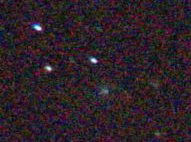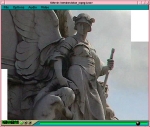

All our movies since 2006 have been on our Youtube
channel. Go there to see some crazy video processing.
Here you'll find old movies in some of the nonstandard codecs supported
by Cinelerra, before internet video became big. Some demonstrate
effects in Cinelerra. Others try to show the quality of the codec.
Others are simply examples of the kind of resolution achievable in
internet downloads at the time.
Some were encoded using a combination of OGG Vorbis and MPEG-4. Others
use a derivative of MPEG-4 where two streams interleave every other
field. These could only be played in Cinelerra.
Still photo aerial timelapse using multiple Motion passes &
Time Average.
Stabilized aerial video using Motion, Time Average, Sharpen.
The Sunset Movie. 4185 JPG photos were shot over 2 years and combined
in Cinelerra to make timelapse movies of sunsets. Histogram and Gamma
were used extensively to correct exposure. ReframeRT was used to adjust
speed after the initial timelapse combination.
For Youtube, the original 1080p footage was scaled down to 426x240,
sharpened, and exported as H.264 + MPEG-4 Audio.
Stardust was the first and last spaceship we'll ever see returning from
beyond Mars orbit to a landing on Earth and Heroine Virtual Ltd. was
there to capture it . Here are 2 EDLs and the 2 raw digital camera
files of the spaceship as seen from Calif* and captured by the mighty
Canon EOS 20D, 15mm F3.5, 100 ISO, 61 sec. The spaceship appeared in
the middle of its expected path and took 45 seconds to travel to the
clouds.
The spaceship was travelling too fast to see anything in the JPG safety
image, but the raw images did better. One .CR2 file contains the sky
with the spaceship and the other file contains the sky with no
spaceship. They provided an opportunity to use Cinelerra's floating
point tools.
When loaded into Cinelerra, one EDL applies histogram and sharpening to
bring out the spaceship. The other EDL subtracts the 2 images to bring
out the spaceship. Don't bother loading these files without 2 gig of
RAM, a copy of Cinelerra, and a long time to process the images.
Click on an image to get a JPG of the output. Click on PROJECT
FILES to get the raw data.
85 30 second exposures were taken by a Canon
EOS 20D, 200mm F2.8 L II, and trapezoidian mount. The ISO was 1600.
Extra motion tracking, white balancing, and stacking were done in
Cinelerra. The location was a mountaintop somewhere in the Morgan
Territory, Calif*.
The trapezoidian mount is a type of Scotch mount, but is light enough to
carry up a mountain even if you're not a heroine.
To remove ambient light, a gaussian blur of 500 pixels was applied to
each frame. The blurred images were subtracted from the original
images. As the comet moved towards the horizon and the ambient light
got brighter, the blurred images also got brighter. The subtracted
frames appear to have the same background light even though the original
movie was much brighter at the end.
The idea was to make a piece of text move around the screen with
rotation. The motion tracker was supposed to keep another piece of
text exactly aligned with the moving text. For extra excitement a
crosshair shows just how close the motion tracker got it.
This particular setting tracked the relative motion between every frame
and the previous frame. This tends to lose accuracy over time. A more
accurate setting tracks the absolute motion between one frame and every
other frame.
They were tracked using relative motion tracking. A specific part of
every frame was matched to the same part in the previous frame. The
rotation and translation was compensated to convert a series of
extremely uneven frames to a reasonably viewable dolly. The
Interpolate effect finally increased the frame rate by averaging
frames.
Only by tracking an extremely small region of the frame, the NASA logo
on the side of the missile, did the motion tracker stay locked on.
That allowed it to track the missile for the entire duration.
Here 347 exposures were hand matched with motion curves to within 10
pixels of exactly one exposure. This didn't match accurately enough to
enhance the image but reduced the search radius for the motion tracker,
making it faster.
Absolute motion tracking matched all 347 frames to the starting frame.
The translation step tracked a single star. The rotation step tracked
a very large area to get the most accuracy. Since logarithmic motion
tracking doesn't work with discrete points of light like stars the
search steps needed to be exhaustive.
The time average effect was applied to the matched frames. To conserve
memory the time average effect was run with subtraction disabled. The
time average was also performed in floating point to expand the dynamic
range.
Finally the resulting floating point image was brightened and sharpened
to reveal objects millions of light years outside our own galaxy, far
below the limit of the camera's CCD.
It's 20 years since the last time we ever attempted to do cell
animation at Heroine Virtual. Back then the most a flat broke
programmer could do was redraw the same image thousands of times on a
paper pad and flip through the pages real fast.
The technology improved considerably since then. Today real cell
animation can be achieved without expensive plastic sheets. Different
layers can move at different speeds. Changes to the timing and
stacking are now automated. Most of all, cell animation can be made at
extremely high resolution without an expensive camera.
Rocket Tanker was the simplest possible cell animation. It took 2
days. All the cells were pencil drawings on paper. Here are all the
cells in Rocket Tanker.
Using 3.5" x 2" frames made the drawing a lot faster and cheaper,
though it would have been easier if each frame was denoted by
crosshairs in two corners, not rectangles.
The cells were all photographed on a 2560x1920 digital camera. They
were stacked in Cinelerra using multiply operations. The interpolate
effect was used liberally to create the illusion of inbetween frames.
Camera and projector curves created all the translation motion.
Background rendering was crucial to getting the timing right.



 PROJECT FILES
STARDUST RE-ENTRY
PROJECT FILES
STARDUST RE-ENTRY
Video: Raw digital camera file
Resolution: 3522x2348
Aspect: 3x2
Size: 12 MB

 TEMPEL 1 IMPACT
TEMPEL 1 IMPACT
Video: JPEG
Resolution: 1024x1024
Framerate: 15
Aspect: 1x1
Size: 29MB
The only moving images of the Deep Impact event captured from Earth are
here. Through the power of the dual Opteron and Cinelerra, we have
subtracted the ambient light to emphasize any changes in brightness of
the comet. Furthermore, every 4 frames were averaged in a moving
average to reduce noise.
![]() MOTION DEMO 1
MOTION DEMO 1
Video: Variable bitrate MPEG-2
Resolution: 960x540
Framerate: 29.97
Aspect: 16x9
Size: 17 MB
When the motion tracker was developed for Cinelerra, this was the first
test project. The background image, of Heroine College of course, was
added when the motion tracking was done.
![]() MOTION DEMO 2
MOTION DEMO 2
Video: Variable bitrate MPEG-2
Resolution: 960x540
Framerate: 59.94
Aspect: 16x9
Size: 112 MB
This stream shows the motion tracker tracking a flashlight in a long
dolly. The tracking is relative. What was a very unstable camera move
looks a little more stable with the motion tracking. To improve the
motion tracking, the original interlaced footage was deinterlaced and
doubled in framerate with the Frames to fields effect.
![]() MOTION DEMO 3
MOTION DEMO 3
Video: Variable bitrate MPEG-2
Resolution: 1280x720
Framerate: 23.976
Aspect: 16x9
Size: 70 MB
If you're flat broke, unemployed, or American you probably can't afford
a 35mm movie camera. There is still a way to make pretty high quality
movies using the motion tracker and a digital still camera. In this
movie 104 high resolution images were taken with a digital camera.
![]() MOTION DEMO 4
MOTION DEMO 4
Video: Variable bitrate MPEG-2
Resolution: 1280x720
Framerate: 59.94
Aspect: 16x9
Size: 48 MB
This movie shows just how little the motion tracker needs to track a
target. The original footage had changing brightness which made
absolute tracking impossible. The target separated from an object
behind it, which made the motion tracker want to track the wrong
object. Finally the target moved around wildly, which required a very
large search radius.
![]() MOTION DEMO 5
MOTION DEMO 5
Video: Variable bitrate MPEG-2
Resolution: 1280x720
Framerate: 24
Aspect: 16x9
Size: 107 MB
Point a digital camera at the sky and you won't see anything. Combine
massive numbers of exposures and you'll see extremely faint objects.
The exposures need to be motion tracked and rotated to compensate for
the Earth's rotation. Unlike normal motion tracking, this motion
tracking needs to be extremely precise to avoid blurring.
 ROCKET TANKER
ROCKET TANKER
Video: Variable bitrate MPEG-2
Resolution: 1920x1080
Framerate: 23.97
Aspect: 16x9
Size: 88 MB
One day someone asked what it would take to launch an oil tanker to
Mars. While not as good as Japanese or Indian animation, Rocket Tanker
depicts one possible scenario in full HD.

 Heroine Statue
Heroine Statue
Video: 720x540 1 MBit/sec MPEG-4
Audio: 44100 130kbit Vorbis.
Composited still photo movie. TV commercial soundtrack. Title Demo
Title Demo
Video: 640x480, 29.97fps, 1 MBit/sec, MPEG-1
Titler animation.
(C) 1997-2024 Starving, flat broke, usually unemployed Programmers
Hosted all these years by Sourceforge